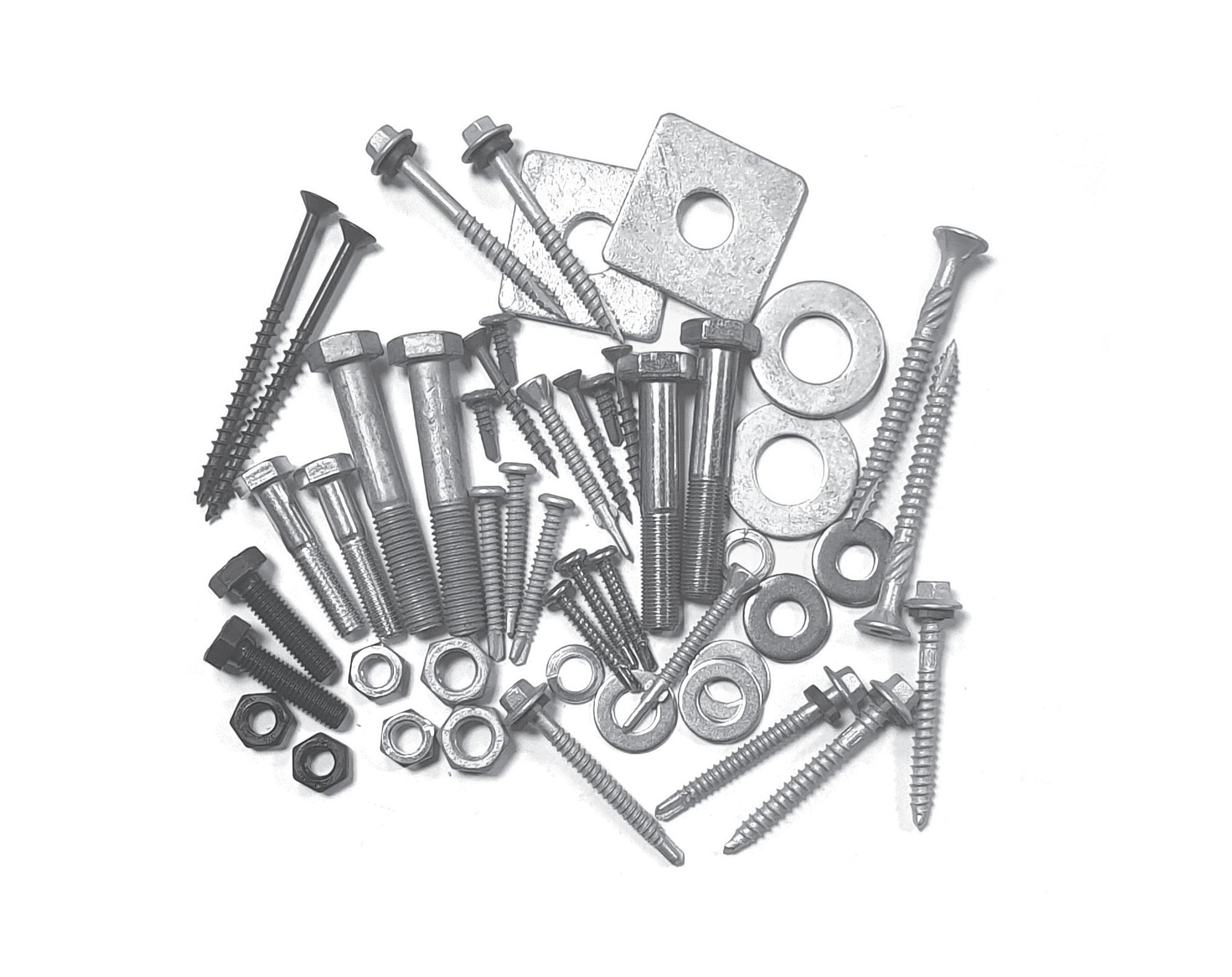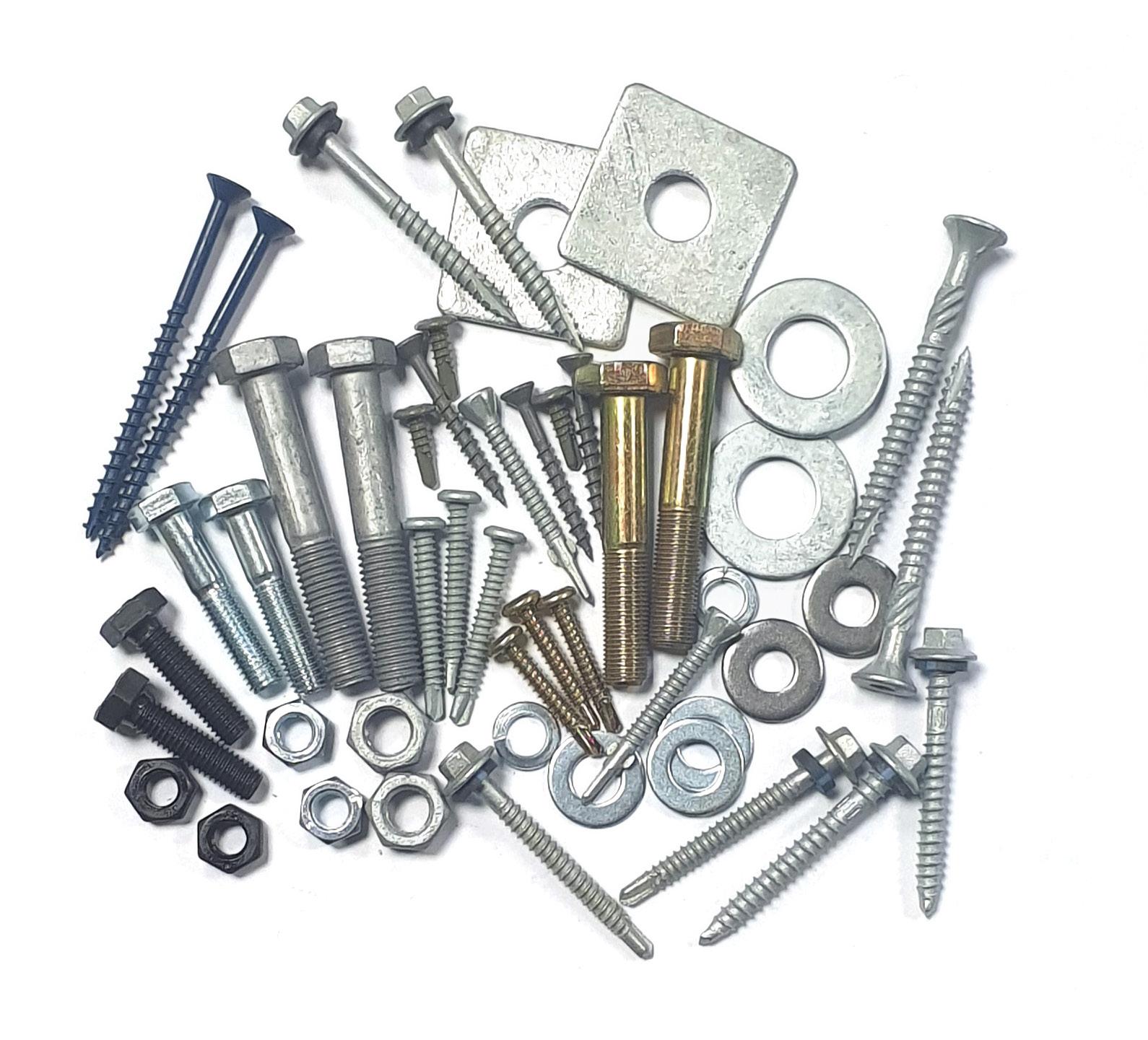COMMON FASTENER COATINGS IN NEW ZEALAND
Approximately 90% of all carbon steel fasteners are plated, coated, or furnished with some other type of supplementary finish. Although the principal reason is to protect against corrosion, such treatments also enhance appearance, control installation torque-tension relationships, minimise threadseizing, and assist product identification.
Coatings are adherent layers applied to the surface of a base metal. For commercial fasteners, practically all deposition is accomplished by electroplating, hot-dipping or mechanically.
Other processes such as spraying molten metal, vacuum metalizing, chemical vapour deposition, ion plating, enamelling and dip and bake are special purpose and economically impractical for stock commercial fasteners.
ZINC
Zinc is favoured as a coating metal because it lasts much longer than uncoated steel. In the galvanic series it is less noble than carbon steel, stainless steel and most other nonferrous metals used in fastener applications. Therefore, in an electrochemical reaction, the Zinc corrodes, and through its sacrifice, the base metal remains protected.
Only after the Zinc has been significantly lost to corrosion does corrosion of the base metal begin. Other plating metals are more noble than carbon steel. If these other coatings are breached, the base metal comes under immediate and often accelerated attack. Zinc is the most popular fastener coating also because it is the least expensive, has good appearance, can be applied in a broad range of thickness, by self-passivation has good-to-excellent corrosion resistance, and is relatively nontoxic.
Zinc plated fasteners may require more tightening torque to develop equivalent preloads in threaded fasteners. Also zinc coatings without some supplementary protection may develop a dull white corrosion product on their surface which is nick-named “white rust”. Because of its unsightly appearance, most zinc plated fasteners are given chromate treatment, which is a chemical conversion process to cover the zinc surface with a hard non-porous film.
This added coating effectively seals the surface, protects it against early tarnishing, and reinforces the fastener’s resistance to corrosion attack. Available coatings are clear (silver) or in a variety of colours (yellow or black most common) and are normally between 3-12 microns (μm) thick depending on fastener size.
MECHANICAL GALV
In mechanical galvanizing a coating of zinc provides sacrificial or cathodic protection to the steel fastener. Because zinc is more reactive than iron, the zinc coating “sacrifices” or corrodes first, protecting the steel substrate.
Mechanical Galvanizing provides excellent coating uniformity, but the process is inconsistent from batch to batch and within each batch, as thickness depends only on the amount of zinc powder. Fasteners are placed in a large rotary barrel along with zinc powder, special promoters and glass impact beads. The mechanical energy generated from the barrel’s rotation is transmitted through the glass impact media that blast the fastener surface with zinc particles. This causes the zinc powder to be mechanically welded on to the surface of the fasteners.
CLASS 3
Class 3 screws are manufactured with a mechanically plated zinc-tin 25 micron (μm) coating for external use in a mild, moderate industrial or moderate marine environments corresponding to corrosivity categories C1 – C3 in accordance with ISO 9223. They should be able to withstand 1000 hours of salt spray/fog testing, without showing more than 5% red rust on the surface of the fastener head.
Class 3 offers better protection than your typical zinc plated fastener, however over time they are typically being phased out and replaced with Class 4. However due to the slightly thinner coating there is less likelihood to have trouble with screw recesses like Square, Pozi and Phillips drive which may see the coating continue in popularity.
CLASS 4
Class 4 screws are manufactured with a mechanically plated zinc-tin 45 micron (μm) coating for external use in a severe industrial or marine environments corrosivity categories C1 – C5 in accordance with ISO 9223. They should be able to withstand 1500 hours of salt spray/fog testing, without showing more than 5% red rust on the surface of the fastener head. If a long life in a severe environment is required, class 5 screws are more appropriate.


CLASS 5 (CATEGORY 5)
Introduced to the Roofing screw market where an increased corrosion protection was required. For use in all environments up to very severe category 5 in accordance with ISO 9223. The life expectancy of the coating in a category 5 environment would be 10 years with no more than 5% base metal corrosion on the head.
The longevity of class 5 screws is less about the thickness of the coating as with Class 3 or Class 4 but what is in the actual coating and its real-world performance.
NOTE: The quality of the coating can vary greatly depending on the supplier, not all coatings are equal as shortcuts can be taken to reduce the overall cost of the fastener.
RUSPERT/E-COAT
Ruspert/E-Coat is a 3-layer surface coating. The distinguishing feature is the tight joining of the baked ceramic surface coating and the chemical conversion film. This gives the fastener a very smooth, even shiny appearance and good rustproof qualities. Some questions over its performance in an exposed outdoor environment, so best for indoor or semi exposed areas.
Ruspert/E-Coat coatings can be made in a small range of colours outside the typical grey of class 3/4 colour coated screws. However, it is not widely available on ex stock fasteners but can be ordered in for customer specific requirements.
HOT DIPPED GALV (HDG)
Premium coating in which steel fasteners are dipped in a hot bath of zinc, a particularly effective way to form a protective layer of zinc that offers excellent defence against corrosion, including outstanding durability, uniformity of coverage and longevity.
The hot-dip galvanizing process consists of several steps that can be categorized into three main stages: surface preparation, galvanizing and inspection. Surface preparation is the most vital part of the process since zinc will only bond to clean, pure steel. Any fastener surfaces that contain dirt, grease or other contaminants will not retain a zinc coating.
The overall zinc coating thickness produced by hot-dip galvanizing fasteners is between 42 microns (μm) and 80 microns (μm), depending on the size of the fasteners. AS 1214 recommends an average of 50 microns
Hot-dip galvanizing produces a zinc coating with a measurable thickness, increasing the diameter of a fastener’s thread. The increased dimensions must be accommodated by over-tapping the corresponding nut to ensure a proper fit
and smooth mating with no binding. Once mated, the zinc coating on the external threads of the fastener will protect the internal threads of the nut or threaded hole that have been stripped of zinc during over-tapping.
To avoid mismatched bolts and nuts that cause installation issues like bad fit, excessive tightening torque and inaccurate bolt tensioning, galvanized high-strength bolts and nuts should be considered a fastener assembly and should be purchased from the same supplier and manufactured according to the same hot-dip galvanizing process. A hot-dip galvanized bolt should not be used with a zinc plated nut, and vice versa. Generally, HDG can only be used on threaded fasteners with a diameter greater than 6mm.
PLATING THICKNESS
As a rule, fastener service life, in a corrosive atmosphere, is proportional to the thickness of its plating. The thicker the plating the longer it will survive. Electroplated fasteners have plating thicknesses ranging from a “flash” coating of insignificant thickness to a “commercial” thickness of 5μm, through to 12μm.
Thicker electroplating is possible but, from an economics viewpoint, quite impractical. Hot-dip galvanising produces much thicker coatings, which in engineering standards are expressed in terms of mass of plating metal deposited per unit area of a coated surface. Standard hot-dip galvanised fasteners have an average thickness coating of 50μm.
Heavier coatings to 80μm are feasible, but such coatings may necessitate adjustments in mating thread fits to a degree that the fastener’s strength properties may be adversely affected. Mechanically plated coating thicknesses are available through the full range offered by either electroplating or hot-dip galvanising.
The build-up of plating on fastener surfaces occurs differently with each of the principal deposition methods. Electroplating deposits the plating metal unevenly with exterior edges and corners receiving thicker coatings. In the fastener’s threaded section, the thickest plating is located at the thread crests and becomes progressively thinner on the thread flanks, with the thinnest deposits in the thread roots.
With hot-dip galvanising, it is just the opposite, with thicker coatings deposited at interior corners and in the thread roots. Because clogging of thread roots is difficult to control, it is usually impractical to hot dip galvanize fasteners of nominal sizes smaller than M8. Mechanical plating tends to deposit the plating metal similarly to hot-dip galvanising but more smoothly and considerably more uniform in thickness over the entire surface.


HYDROGEN EMBRITTLEMENT
High tensile or hardened fasteners can absorb hydrogen atoms which can concentrate in areas of stress, causing minute cracks which can suddenly fail. To avoid this the hydrogen atoms can be diffused by baking the product immediately after plating prior to chromating at a temperature of 190-210 degrees C for a period depending on the grade and size of the fastener.
It is unadvisable to plate PC 10 or SAE grade 8 and higher fasteners after purchase unless the plater is also able to perform and guarantee the de-embrittlement process.

Acknowledgement: American Industrial Fasteners Institute for some of the information provided.


